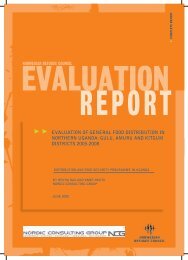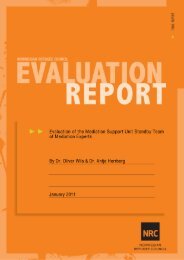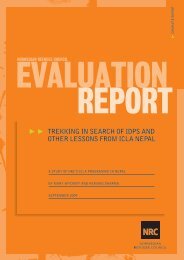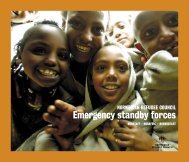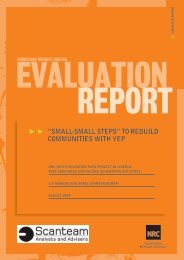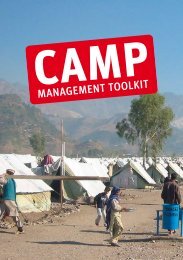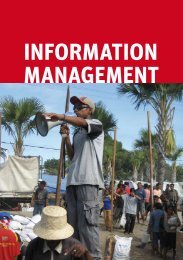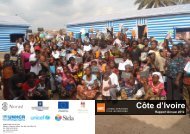NRC PROGRAMMES - Norwegian Refugee Council
NRC PROGRAMMES - Norwegian Refugee Council
NRC PROGRAMMES - Norwegian Refugee Council
You also want an ePaper? Increase the reach of your titles
YUMPU automatically turns print PDFs into web optimized ePapers that Google loves.
The <strong>Norwegian</strong> <strong>Refugee</strong> <strong>Council</strong> (<strong>NRC</strong>)is an independent, humanitarian non-governmental organisationwhich provides assistance, protection and durable solutionsto refugees and internally displaced persons worldwide.www.nrc.no<strong>NRC</strong> <strong>PROGRAMMES</strong>CAMP MANAGEMENTEDUCATIONEMERGENCY FOOD SECURITY AND DISTRIBUTIONInformation, Counselling and Legal Assistance (ICLA)SHELTER
IntroductionIntroductionThe <strong>Norwegian</strong> <strong>Refugee</strong> <strong>Council</strong> aims to provide relevantassistance to refugees and internally displaced persons(IDPs), hence contributing to durable solutions that canlead to an end to displacement. For more than sixty years,the <strong>Norwegian</strong> <strong>Refugee</strong> <strong>Council</strong> (<strong>NRC</strong>) has providedhumanitarian assistance to refugees and IDPs in differentconflict-affected environments.To be able to serve our target group in the most effective and professionalway, <strong>NRC</strong> has developed and focused its solid international operationalexpertise into five core programme activities within the field of humanitarianassistance. These five core activities that form the basis of <strong>NRC</strong>’sprogrammes include:• Camp Management• Education• Emergency Food security & Distribution• Information, Counselling & Legal Assistance• ShelterThis brochure provides an overview of <strong>NRC</strong>’s five core areas of expertise,and presents the approaches, principles and methods that have beendeveloped to ensure that our assistance is accurately targeted, efficientlyand timely provided, and contributing to a more secure future for refugeesand IDPs around the world in a sustainable manner.ISBN 978-82-7411-188-5© <strong>Norwegian</strong> <strong>Refugee</strong> <strong>Council</strong> – Edition August 2008This document is protected by copyright. All rights reserved.Reproduction of the contents of this document is prohibitedwithout authorization from <strong>Norwegian</strong> <strong>Refugee</strong> <strong>Council</strong>.Design: Cox Oslo asPrint: Gamlebyen GrafiskBrochure circulation: 15,000Cover photo: Roald Høvringwww.nrc.no<strong>NRC</strong> CORE ACTIVITIES 3
tittelCamp managementRationaleIt is estimated that around a quarter of all displaced communitieslive in camps or camp-like settings. With millions ofrefugees worldwide, and an escalating number of internallydisplaced people, there is a need for the effective managementof camps, as part of an effective humanitarian relief response.With a wide range of stakeholders and service providersinvolved in the life of a camp, camp management focuses ondeveloping effective coordination mechanisms that supportthe provision of assistance and protection. Camp managementaims to ensure that gaps in services are identified, duplicationsare avoided, and the fundamental human right to life withdignity, is upheld for the camp community.ObjectiveThe overall objective of <strong>NRC</strong> camp management is to secureand to uphold the rights of refugees and internally displacedpersons (IDPs) under international law, who are living incamps or camp-like situations. This includes working toprovide an adequate standard of living in accordance withinternational minimum standards, at all levels of planning,practice and participation.CAMP MANAGEMENTWhilst camps do not provide durable solutions to situations of displacement, causedby conflict or natural disaster, they are often the only refuge for communities whohave been forced to flee their homes and are seeking safety, shelter and materialassistance.4 <strong>NRC</strong> CORE ACTIVITIES<strong>NRC</strong> CORE ACTIVITIES 5
Camp managementCamp managementauthorities, camp leaders and members ofthe host community, amongst others, <strong>NRC</strong>as a Camp Management Agency collectsdata and disseminates information, whichensures provision in key sectors. One of thekey responsibilities in camp management isto monitor assistance such as shelter, distributionof food and non-food items, waterand sanitation facilities, health services andeducation.Central to best practice in camp managementis promoting the active participationof the camp residents in the daily activitiesof the camp, with a view to developingself-management and effective governance.To this end <strong>NRC</strong> as a Camp ManagementAgency mobilises communities to formcamp committees to participate in theplanning, implementation and evaluationof camp management projects. This reducesdependency, develops self-esteem, harnessesskills and capacities and generatesa vision of a future beyond displacement.Community participation in Sri Lanka IDP campActivities for children is an important part of camp life.ApproachTarget Group<strong>NRC</strong>’s primary target groups are displacedpopulations living in camp settings – includingrefugees, IDPs and returnees.Secondary target groups are humanitarianactors, such as the various UN agencies,NGOs, international organisations anddonors, as well as governments and authorities.Phases<strong>NRC</strong> camp management programmes canbe implemented in all phases of displacementin order to ensure protection andassistance for displaced communities.Depending on the context, <strong>NRC</strong> will designits camp management programme accordingto developments in the camp’s lifecycle, e.g. activities during camp set-up willdiffer from activities during camp closureand phase-out.Durable Solutions<strong>NRC</strong> recognises that camps do not providedurable solutions for displaced communities.Working with the displaced population toadvocate for, identify and ensure sustainablesolutions are reached, is a key objective forcamp management. Durable solutions mayentail return to the place of origin, integrationinto the host or surrounded communityor resettlement in a third location.The type of settlements that are defined ascamp settings can vary depending on theemergency and the coping strategies inplace. <strong>NRC</strong> works in the following typesof settlements:1. Camps (planned camps, self-settledcamps, reception centres, transitcamps)2. Mass shelter in collective centres3. Dispersed settlements4. (Early) return areas<strong>NRC</strong> defines camp management as “on-sitecoordination of all activities and serviceswithin one camp”. Coordinating withhumanitarian actors, governments andA key responsibility of the Camp ManagementAgency is to take account of a varietyof issues which cut across both the technicaland the social elements of camp life. Theseissues include the impact that a camp hason the environment, the need for representationof women and men, boys and girls,and the specific protection needs of vulnerablegroups, e.g. the elderly and peopleliving with HIV/AIDS.Working Principles and MethodsEquality of Participation through Age,Diversity and Gender Mainstreaming<strong>NRC</strong> works to promote gender equalityand respect for human rights, particularlywomen’s and children’s rights, regardlessof their ethnic, social and religious background.Mainstreaming age, gender anddiversity entails the meaningful participationof girls and boys, women and menof all ages and backgrounds.EnvironmentMass population upheaval, and associatedhumanitarian relief operations have environmentalconsequences, not least in termsof the natural resources used by camppopulations for a variety of purposes intheir daily lives. The environmental impactof these activities is influenced by manydecisions throughout the camp’s life cycle,from the time a site is selected to the time acamp is closed. Best practice in campmanagement aims to generate awarenessof environment-related issues and the longerterm management of natural resources.Understanding environmental managementas central to effective protection, and takingthe needs of both the camp and the hostpopulations into account are of key importance.Do No HarmOften operating in circumstances of violentconflict and political complexity, campmanagement adopts a reflective approachwhich acknowledges that humanitarianrelief can produce unintended and evencounter-productive consequences. Bringingresources into situations of conflict and/ordisaster may exacerbate the very conflictsand violence that we seek to relieve. Whilstworking to maintain the humanitarianimperative, the right to receive humanitarianassistance and to offer it, <strong>NRC</strong> is awarethat best practice in camp managementis underpinned by an awareness of thecontext of activities, and the principleof ‘firstly, do no harm.’Coordination and PartnershipsAs the focal point for the inter-agencyCamp Management Project, and a partnerin the global Camp Coordination andCamp Management (CCCM) Cluster,<strong>NRC</strong>’s activities aim to create and contributeto different fora for advocacy andbest practice in camp management.In the field, <strong>NRC</strong> participates in nationalCCCM clusters. <strong>NRC</strong>’s camp managementinvolves partnerships with a wide range ofhumanitarian actors and includes workingclosely with national governments and6 <strong>NRC</strong> CORE ACTIVITIES <strong>NRC</strong> CORE ACTIVITIES 7
Camp managementCamp managementProjects examples:• The inter-agency Camp Management Toolkit 2008 publication,with the initial 2004 draft version, has been usedby over 50 organisations. <strong>NRC</strong> is the coordinator of theCamp Management Toolkit/Camp Management Project,which includes UNHCR, IOM, DRC, IRC, UNOCHA, and<strong>NRC</strong>.• The development of the inter-agency Camp ManagementTraining Roster, with over 60 stand-by staff trained andable to deliver camp management training.• Camp Management training and coaching materials fora wide range of stakeholders, including governments,camp communities and NGOs/international organisations/UNagencies.• Camp Management training delivered regionally andnationally, through the CCCM cluster and the CampManagement Project, in around 15 countries withseveral hundred participants.D.R. CongoNorthern UgandaSri LankaCamp Management training in Lebanon.authorities, in many aspects of camp administration.This includes the national authorities’responsibility for site selection anddesign for camps, ensuring security and thecivilian character of the camp, and provisionof documentation, and identificationof durable solutions to displacement.Another key partner in camp managementis the camp residents, who have representativeson the camp management team andare encouraged to form committees toidentify and advocate for the rights of thecommunity. Committee members arerepresentative of the camp population(according to gender, age and diversity),and meet regularly to identify key issuesand plan collective action to meet commonneeds.Camp Management ActivitiesThe <strong>Norwegian</strong> <strong>Refugee</strong> <strong>Council</strong> offerscamp management expertise and capacityin three key ways:· As a camp management agency inthe direct management of camps: Campmanagement is a holistic approach toensuring assistance and protection fordisplaced communities living in campsor camp-like situations. <strong>NRC</strong> campmanagers work with a wide range of stakeholdersto establish effective coordinationmechanisms, act as the camp residents’advocate, and promote the participationof the community in the life of the camp.· Through the provision of camp managementtraining and coaching: <strong>NRC</strong>recognises that well-trained staff, withthe necessary knowledge, skills and attitudesis central to the effective managementof camps. Likewise, training for a widerange of stakeholders, including governmentsand authorities, humanitarianactors, camp residents and members ofthe host community, contributes to raisingthe standard of living of displacedpeople. <strong>NRC</strong> provides camp managementtraining at regional, national and fieldlevel, coordinating a roster of inter-agencytrainers, and delivering training on behalfof the CCCM (Camp Coordination andCamp Management) Cluster, and theCamp Management Project (an interagencyinitiative which includes: UNO-CHA, UNHCR, IOM, DRC, IRC, <strong>NRC</strong>).Coaching programmes ensure follow-upto training, and on-going support forcamp communities in the developmentof self-management capacity.· Through camp monitoring: Campmonitoring means working to developcoordination bodies and systems in campsituations, and collecting and disseminatinginformation. This data can revealgaps where additional assistance orprotection is needed, and prevents theduplication of services. Monitoring takesplace throughout the phases of a camp’slife cycle: Its initial planning and set-up,the daily activities and care and maintenanceof the site, through to findingdurable solutions for the community,and the closure of the camp.Intensified fighting between theGovernment army and a number ofarmed groups resulted in increaseddisplacement and the establishmentof a number of camps in EasternD.R.Congo since 2006. Throughthe Camp Coordination and CampManagement (CCCM) workinggroup, <strong>NRC</strong> was designated as theCamp Management Agency for fourcamps – hosting nearly 50,000IDPs – around Goma in North Kivuin October 2007. In these camps,<strong>NRC</strong> aims at improving the livingconditions for, and protection of, theIDPs, by strengthening the capacitiesof the camp and host populations,and through on-site coordinationof several stakeholders working indifferent sectors in the camps.Weekly coordination meetings areorganised in each camp and campleadership structures are establishedwith representative participation ofthe different social groups.The armed conflict in NorthernUganda between the Governmentarmy and the LRA began more thantwenty years ago. It has resulted inthe displacement of more than 1.4million people, and crimes againstthe civilian population including theabduction of children, rape andtheft which have left communitiestraumatised by violence. <strong>NRC</strong> hascamp management field teams andoffices permanently based in twocamps called Amuru and Pabbo inAmuru district, in addition to campsin Kitgum district. <strong>NRC</strong>’s presenceaims to monitor and support thecurrent return process, as well asservice provision in still existingcamps. With the seeds of hope sownin recent peace talks, <strong>NRC</strong> is alsoworking to ensure protection forthe community in their transitionfrom life in the camp back to theirhomes and land; places of originwhich many children born insidethe camp, have never before known.Following multiple displacements asa result of both a protracted conflictand the 2004 tsunami, <strong>NRC</strong> worksin Sri Lanka’s North and Eastproviding assistance to camp communities.Maximising links betweencamp management, shelter andprotection monitoring projects,<strong>NRC</strong> has adopted a training approach.The aim is to build the skillsand self management capacitieswithin the numerous, small anddispersed settlements and camps.<strong>NRC</strong>’s presence has mobilised theelection of effective site leadershipand camp committees which meetregularly to identify and addressissues of concern in the community.8 <strong>NRC</strong> CORE ACTIVITIES <strong>NRC</strong> CORE ACTIVITIES 9
tittelEducationRationale• Protracted conflicts and displacements have led to deprivationof basic schooling for a large number of people across theglobe. It is estimated that some 39 million of the 77 millionchildren and youth without access to basic education, are orwere affected by conflicts (2007).• <strong>NRC</strong> sees its education support as contributing to the GlobalMillennium Development Goal of providing basic EducationFor All by 2015, thereby helping to protect all individuals’ rightto basic education.• Since 1997 the organisation has called for education to beregarded as the “4th component of humanitarian assistance”,on a par with food and water, medical attention and shelter,and to be planned for accordingly.ObjectiveSThe primary objectives of the <strong>NRC</strong> education activities are to• respond rapidly to educational needs among the <strong>NRC</strong> targetgroups and their communities• contribute to peace-building through training on conflictmanagement and human rights, and by facilitating crossfaction contacts and reconciliation• support individual and community rehabilitation effortsthrough the provision of relevant knowledge and skillstraining needed to ensure livelihood and improved livingstandardsEducation programmes organised by <strong>NRC</strong> provide• mental relief in a protective and caring environment• protection against recruitment to armed groups, abductionand exploitation• messages, knowledge and skills relevant to the actualsituation – and for the future• necessary competence and skills to teachers and othereducation personnel• increased capacity and understanding among educationauthority officials, parents and communitiesA TEP class in Burundi.educationIn the early nineties <strong>NRC</strong> started the development of working principles and approachesto respond effectively to needs for education in phases of conflict, displacement andrehabilitation. In 2008 education is supported in 15 countries, with priority given tochildren and youth who have lost out on basic education.10 <strong>NRC</strong> CORE ACTIVITIES<strong>NRC</strong> CORE ACTIVITIES 11
EducationEducationEducation Models used by <strong>NRC</strong>For 9-12-year-olds, in some casesadolescents and youth• A catch-up model such as the TEP– Teacher Emergency Package,which offers an eight to twelvemonth programme of literacy,numeracy and selected subjects.Goal: Children enter the ordinaryschool system in 3rd grade and hopefullycomplete their primary school.An ALP class in a return area in Liberia.Important topics• Learning Environment, Child/Youthfriendly methodology and psychosocialunderstanding• Teacher Ethics and Code of Conductfor the protection of the children• Transmission of knowledge, recognised,meaningful and useful in thelearners’ daily lives. Gender, HIV/AIDS and Human Rights sessionsare part of the programme.ApproachTarget groups<strong>NRC</strong> primary target groups are refugees,returnees and IDPs. In education programmesthe following groups are givenpriority:• Children and youth who have missed outon their basic education, providing equalaccess for girls and boys, and removingobstacles to girls’ enrolment and completion• Qualified or potential teachers withinthe target groupsSecondary target groups can include• Local or host-community children andyouth (to promote cooperation, integrationand reintegration), so long as themajority of the beneficiaries are fromthe main target groups.• Education officials and teachers• Adults of special relevance to theeduca tion programmesPhases<strong>NRC</strong> is prepared to respond to educationneeds in all phases of crisis and emergency:acute emergencies, chronic crisis andreturn and rehabilitation phases. BeforeTeacher trainers in Central African Republic discuss training for parent-teachers.exiting from a country <strong>NRC</strong> tries to findother actors who can continue the activities,be it government, local NGOs or institutionsor international NGOs or agencies.Working principles and methods• <strong>NRC</strong> cooperates with national and localeducation authorities, to ensure approvalof activities, agree on needed educationalresponse and possible subsequent takeover.Local involvement and cooperationis seen as instrumental in ensuring thatcombined efforts will strengthen theschool system in responding to emergenciesfor affected populations.• <strong>NRC</strong> most often works hands-on, implementingprogrammes, but implementationcan also be done in cooperation withother local or international actors.• Training and follow-up of trainers andteachers are central. Lack of qualifiedteachers is a general problem in emergencies,and there is a need to train teachersin the special skills, methods and knowledgerequired to respond appropriatelyin the given circumstances.• <strong>NRC</strong> is advocating for girls’ right toeducation, always trying to find ways toencourage and facilitate girls’ enrolmentand recruitment of female teachers.CoordinationIn addition to coordination with nationaland local authorities:• <strong>NRC</strong> always tries to coordinate educationinitiatives with UN agencies and otherinternational and local actors to ensurethe most efficient response to the educationneeds• <strong>NRC</strong> also works through international and<strong>Norwegian</strong> networks to advocate for andcoordinate efforts for education in emergencies,notably the Inter-Agency Network forEducation in Emergencies (INEE). <strong>NRC</strong>adheres to the INEE Minimum Standardsfor Education in Emergencies, ChronicCrisis and Early Reconstruction.• <strong>NRC</strong> strives to create synergies andcooperation among its core activities.ActivitiesNational or generic education materials areused, adapted and developed as relevant.<strong>NRC</strong> has introduced a few education andtraining models for rapid adaptation andimplementation where needed.Training of Trainers and TeachersGood education programmes depend mostof all on well prepared trainers and teachers.Planning and training for an agreed programmeis done in cooperation withnational and/or local education officials.Goal: Teachers provide a safe and inspiringlearning environment for pupils.• An accelerated learning programme,often called ALP, where pupilscan get a primary school exam in areduced number of years, e.g threeyears instead of six.Goal: Pupils obtain a primary schoolcertificate recognised by the authorities.For 14-18-year-olds• The Youth Education Pack, YEP, isa full year programme with literacy/numeracy, life skills and vocationalskills training.Goal: The youth acquire functionalliteracy, increase their self-relianceand improve their chances of securinga job and a family income.• Peer Education. Training of youngpeople who can act as trainers fortheir peers. Topics can be coreacademic subjects as well as health,HIV/AIDS, gender, peace andhuman rights.• Support to other local youtheducation programmesImportant topics and challenges• Learning Environment, Child/Youthfriendly methodology and psychosocialunderstanding• Teacher Ethics and Code of Conductfor the protection of the children• Transmission of knowledge that ismeaningful and useful in the learners’daily lives. Gender, HIV/AIDSand Human Rights sessions are partof the programme.12 <strong>NRC</strong> CORE ACTIVITIES <strong>NRC</strong> CORE ACTIVITIES 13
EducationEducationProjects examples:Exit Angola: Resultsof 12 years of TEP• A tripartite agreement between theMinistry of Education, Unicef and<strong>NRC</strong> since 2000 defined respectiveroles and cooperation• 3 200 teachers trained, pre-serviceand in-service, and followed up. Onthe MoE payroll, they have receivedadditional training to be able to teachin the school system• 525 supervisers and inspectors, themajority attached to the educationsystem, trained to monitor and superviseteachers• 212 000 children/youth benefitedfrom the one-year programme; themajority transferred to the officialschool system• 211 schools/542 classrooms constructedin ten provinces, withcommunity participationColombia – helping IDP children back into schoolIn Colombia <strong>NRC</strong> is joining handswith local NGOs and educational institutionsto support IDP children to getback into school. Many IDP childrenstruggle to adapt to a new environmentand their new situation in displacement.Often IDPs are coming fromrural areas into more urban settlements,most of them ending up in poorand vulnerable communities. Largenumbers of these children are notgoing to school. Through the programmeof “Learning Circles” children aretaken into a safe learning environmentwhere they can learn according toA “Learning Circle” at work in Colombia.their level and needs. In small groupsthey are allowed to express themselvesin different ways and gain basic knowledgewhich will be important in theircontinued schooling. They also learnto avoid violent behaviour, which oftenis a result of the rough and vulnerablecommunities they are living in. Aftera year in the “Learning Circle”, orearlier if they are found to be ready,the children are integrated into a local“mother” school. All participants inthe learning circles are registered witha “mother” school to secure them aplace in the ordinary school system.YEP students acquiring tailoring skills in Sudan.Sudan – giving young people skills for a futureSouth Kordofan, in the middle ofSudan, was one of the areas hardestaffected by the civil war. It is alsoone of the areas in Sudan with thehighest number of people returningfrom displacement. <strong>NRC</strong> is runningthe YEP programme (Youth EducationPack) for rural youth in this area.For young people returning to SouthKordofan there are few schoolingopportunities. Through the YEP programmethe young students learnbasic reading and writing skills, lifeskills such as health, peace, humanrights and physical exercise, and apractical skill aimed at giving theman opportunity for employment orgenerating income. The skills offeredvary from centre to centre (in 2008<strong>NRC</strong> is running nine YEP centres),but include carpentry, tailoring,baking, poultry, agriculture andbuilding. The students are findingthat their products can be soldin the local markets, and are eagerto find ways of continuing their activityafter the one year of YEP training,alone or in groups. The YEPprogramme is striving for a genderbalance and is having around 50%boys and 50% girls. For young girls,and especially young mothers (aroundhalf of the female students aremothers), there are few alternativesrelated to education and skills training.Through YEP they can learnskills which will enable them to providesome income for themselves andtheir families.In Georgia YEP students are acquiring skills inpottery and agriculture.Georgia – training for futureemploymentIn Georgia youth living in collective centresfor IDPs are disadvantaged both regardingeducation in general and for training for jobopportunities. To give opportunities to someof these IDP youth, <strong>NRC</strong> is running a fourmonth training programme in cooperationwith a local NGO and state vocational centres.The youth are learning basic computerskills, life skills such as gender awareness,HIV/AIDS, tolerance and human rights, andsome practical vocational skills. The practicalskills include hairdressing, car repair, pottery,agriculture, computer design and computerrepair. Both the local NGO and the vocationalcentres are committed to finding jobs for thestudents after graduation. The fact that theyare getting certificates from the state vocationalcentres is already a big step forward toincrease their chances of finding employment.14 <strong>NRC</strong> CORE ACTIVITIES <strong>NRC</strong> CORE ACTIVITIES 15
tittelEmergency food security and distributionRationaleThe right to adequate food is “realized when every man,woman and child, alone or in community with others, hasphysical and economic access at all times to adequate foodor means for its procurement”. 1) Conflicts are a primaryobstacle to realizing this fundamental human right in manyparts of the world. Losses of human lives and assets, populationdisplacements and insecurity prevent or deeply disrupt agriculturaland economical activities as well as food procurementand preparation. Food crises often result in malnutrition,disease and death.Through its Emergency Food Security and Distribution coreactivity, <strong>NRC</strong> intends to promote the right to adequate foodof refugees, internally displaced persons (IDPs) and returnees,and thus to safeguard lives, preserve nutritional status andcontribute to livelihoods and recovery.ObjectiveS• to fulfil the immediate food needs of refugees and IDPsand maintain their adequate nutritional status in emergencysituations• to fulfil the immediate non food item needs of refugeesand IDPs in emergency situations• to promote self reliance, and support durable solutionsas soon as the context allows• to contribute to food security, livelihoods and recoveryin various phases of displacement• to ensure school-age children proper food intake in orderto promote education, alleviate short-term hunger andimprove their learning capabilities1)Committee on Economic, Social and Cultural Rights, GeneralComment 12, UN document E/C.12/1999/5EMERGENCY FOOD SECURITYAND DISTRIBUTIONFood distribution in Uganda.Conflict, with its associated collapse of social, political and economic systems, is a major causeof food insecurity for households. Agricultural production is disrupted, employment opportunitiesare decreased and livelihood assets are looted or destroyed. Consistent with saving lives andcurbing malnutrition, the overall objective of this core activity is to support the food securityand livelihoods of people affected by displacement.16 <strong>NRC</strong> CORE ACTIVITIES<strong>NRC</strong> CORE ACTIVITIES 17
Emergency food security and distributionEmergency food security and distributionInternally displaced woman tending to daily chores, Pakistan.<strong>NRC</strong> distributes goats to IDPs returning home. This woman belongs to a cooperativein a Northern Uganda village which received 17 goats.Examples of livelihood projects.ApproachTarget groupsIn compliance with <strong>NRC</strong>’s global mandate,the primary Emergency Food Security andDistribution target groups are refugees,internally displaced persons (IDPs) andreturnees.Within the main target group, certaingroups are more vulnerable to food shortagesthan others (children under five, pregnant/lactatingwomen, persons sufferingfrom serious medical conditions). Othersare unable to meet their family minimumfood consumption requirements due totheir social, physical or household situation(single parents, child headed household,disabled, elderly, women, etc.). Whenimplementing a project, <strong>NRC</strong> identifies themost food insecure - according to internationallyand locally recognised vulnerabilitycriteria – and targets them first.Sometimes, displaced people live mixedwith the local host population. The lattermay face the same problems in accessingfood. When they have similar needs, <strong>NRC</strong>may include them in the target group.PhasesIn order to respond to needs in variousstages of a conflict and to ensure thatrefugees, IDPs and returnees have accessto adequate food at all times, <strong>NRC</strong> designsdifferent Emergency Food Security andDistribution projects depending on thecontext:• In acute emergencies, food and non fooditem distributions are often an absolutenecessity for survival. <strong>NRC</strong> respondsrapidly with this food assistance.• In protracted crises, the situation maybecome more stable thereby increasingthe possibilities for the population tosecure part of their food requirementsthrough sources other than distribution.<strong>NRC</strong> may implement a complementaryapproach between direct distributionsand livelihood recovery. <strong>NRC</strong> may refinetargeting from general distribution to amore targeted system as well.• In return and recovery phases, food assistancemay still be necessary for a periodof time. Return kits may be distributedand food security and livelihood programsaimed at securing food needs ofreturnees in the longer term may beimplemented.In all phases, <strong>NRC</strong> may implement Foodfor Education programmes in order topromote education, alleviate short-termhunger and improve cognitive learning.Working principles and methods<strong>NRC</strong> designs Emergency Food Securityand Distribution projects that areculturally and contextually appropriateand acceptableFirst, <strong>NRC</strong> programmes are based onassessments of situation and needs whichinclude careful analysis of the local economy,food production and coping strategies.<strong>NRC</strong> then ensures that all activities implementedare in accordance with culturaland social habits and that they are sensitiveto gender, age and diversity. Finally, <strong>NRC</strong>puts in place a monitoring and evaluationsystem as soon as the project starts in orderto continuously analyse project implementationand impact. It can readjust its interventionaccording to whether the situationimproves or deteriorates.<strong>NRC</strong> applies participatory andcommunity based approaches<strong>NRC</strong> involves the affected populations inproblem definition, solution identificationand activity implementation. In addition,<strong>NRC</strong> ensures proper dissemination ofinformation to beneficiaries and transparencyof the beneficiary selection process.<strong>NRC</strong> supports the self-reliance ofaffected populationsIn order to support durable solutions, <strong>NRC</strong>complements direct distributions of foodand non-food items with livelihood projectsaimed at enhancing food security forthe target groups in the longer term.<strong>NRC</strong> contributes to strengthening localcompetences and capacities by encouragingparticipation of key local actors(local authorities, local organisations).<strong>NRC</strong> uses local labour, goods, materialsand services when available and only aftera careful analysis of the possible negativeimpact on the local market.Coordination<strong>NRC</strong> ensures coordination with partnersand stakeholders at local, national andinternational levels. In the countries ofintervention, <strong>NRC</strong> works with local andnational authorities as well as targetgroups, wider community groups and traditionalstructures. <strong>NRC</strong> cooperates withnational and international NGOs both atfield and international levels. <strong>NRC</strong> worksclosely with UN agencies and takes the roleof UN cooperating partner where relevant,especially with the World Food Programme(WFP).Internally, <strong>NRC</strong> ensures coherence andmutual strengthening of activities withother <strong>NRC</strong> core activities.Food Security definitionand factsAll people, at all times, have physicaland economic access to sufficient,safe and nutritious food tomeet their dietary needs and foodpreferences for an active and healthylife” (FAO World Food Summit1996)About 850 million people in theworld are undernourished. In 2006,39 countries faced food crisesrequiring emergency assistance. Outof them, 25 were caused primarilyby conflict and its aftermath, or acombination of conflict and naturalhazards.Furthermore, approximately 50million people worldwide live in anarea marked by a protracted crisisthat has lasted for five years ormore.Source: Food and Agriculture Organization ofthe United Nations (FAO18 <strong>NRC</strong> CORE ACTIVITIES <strong>NRC</strong> CORE ACTIVITIES 19
Emergency food security and distributionEmergency food security and distributionProjects examples:Harvest time.<strong>NRC</strong> Emergency Food Security andDistribution activities<strong>NRC</strong>’s main activities are:• Food distribution: <strong>NRC</strong> provides food torefugees, IDPs or returnees. Distributionsmay cover 100% of a person’s daily foodrequirements (2,100 kcal/person/day) orless, depending on the context. Fooddistribution may be general – everybodyreceives food, or targeted – the mostvulnerable persons within the populationreceive food. <strong>NRC</strong> food distributions areoften implemented in partnership withWFP.• Non-Food Item distribution: <strong>NRC</strong> distributesdifferent types of non food itemsaccording to the needs of the beneficiaries:household kits (mattress, blanket, plasticsheeting, jerry can), kitchen sets, hygienekits, clothes, etc.• Food for Education: In order to increaseschool children’s enrolment and attendance,and to ensure that pupils eatbalanced meals every day, <strong>NRC</strong> provideson site feeding and take-home rations togirls and boys. These projects are oftenimplemented in partnership with WFP.• Emergency Food Security and Livelihoods:<strong>NRC</strong> implements Food Securityand Livelihood projects aimed at promotingself-reliance, and supportsdurable solutions as soon as the contextallows. <strong>NRC</strong> interventions are gearedtowards food accessibility, availability andutilisation. By supporting agriculturalproduction and by enhancing incomegeneration, <strong>NRC</strong> aims at securing foodneeds for people in the longer term.Furthermore, <strong>NRC</strong> may consider environmentalconservation activities, to reducefood security in the long term.• Capacity building: <strong>NRC</strong> may supportlocal organisations with training andadvice in food security and distribution.Somalia – emergency phaseThe outbreak of war in Mogadishu inlate March 2007 triggered massivedisplacement of the population withinthe city and to neighbouring areas.IDPs sought refuge in temporary settlementslacking the basics. In anextremely tense security situation,<strong>NRC</strong> provided emergency assistanceto the displaced by distributing nonfood item kits. The latter - composedof plastic sheeting, blankets, kitchensets, soap and jerry cans – aimed atimproving their basic living conditions.Since then, <strong>NRC</strong> continues todistribute emergency kits to newlydisplaced families.Uganda – protracted crisisThe 20 years of war between theUgandan Government and the Lord’sResistance Army (LRA) has displacedclose to 1.500.000 people in northernUganda. Since 1997, <strong>NRC</strong> hascarried out Emergency Food Securityand Distribution projects. Over theyears and according to the contextevolution, <strong>NRC</strong> has developed severalcomplementary projects that aim atfulfilling IDPs’ immediate food needsas well as enhancing their longerterm food security. <strong>NRC</strong> activities inNorthern Uganda include:• Food distribution to an averageof 800 000 IDPs living in campsin Gulu and Kitgum districts inpartnership with WFP• Food for Education programmetargeting 115,000 pupils in 177primary schools of Kitgum district(with WFP)• Non-food item distribution in GuluIDP camps (with UNICEF)• Food Security and Livelihoodproject which includes agriculturalsupport, livestock interventions,income generating activities andenvironmental conservation activities.The project targets vulnerableIDPs that face more difficulties inmeeting their families’ basic foodneeds in Gulu and Kitgum districtsAngola – from emergencyto return and recovery<strong>NRC</strong> started operating in Angola in1995. Until the peace agreement in2002, <strong>NRC</strong> responded to the crisiswith emergency distribution programsto IDPs (food and non food items).After the ceasefire agreement, <strong>NRC</strong>gradually modified its programmesto focus on return and resettlementof IDPs and returning refugees. <strong>NRC</strong>implemented a Food Security andLivelihood Project that aimed atcreating conditions to improveself-sufficiency of the people. Agricultureand livestock interventions,including seed and tool distributions,oxen and goat distributions as wellas trainings, were some of the mainproject activities. After contributingto emergency assistance and to longterm durable solutions, <strong>NRC</strong> phasedout from Angola at the end of 2007,considering that the communitiesnow were sufficiently strong enoughto continue the development process.20 <strong>NRC</strong> CORE ACTIVITIES <strong>NRC</strong> CORE ACTIVITIES 21
tittelInformation, counselling and legal assistance (icla)Information, Counsellingand Legal Assistance (ICLA)Durable solutions are different for refugees and IDPs. Some agencies refer to three durablesolutions for refugees: voluntary repatriation, local integration or resettlement in a third country.This implies a change in the legal status: a refugee is not any longer a refugee.Information and counselling session forIDPs in Khartoum.RationaleThere is no consensus on durable solutions to internaldisplacement, partly because internal displacement isnot a legal status that can be brought to an end. Yet, thepossibilities are very similar to those of refugees, exceptthat all take place within the borders of a country:return to the place of origin, local integration in theareas of refuge or settlement in another part of thecountry. Displacement ends when one of these solutionsis found and all displacement related discriminationagainst IDPs stops. Displacement is caused byhuman rights abuses, wars, natural disasters anddevelopment. It is broadly acknowledged that while indisplacement, individuals and groups are more vulnerableand are subject to human rights abuses, disempowermentand marginalization. Their vulnerabilitymay continue when they are no longer physically displaced,i.e. when they have returned to their places oforigin, have integrated locally or resettled somewhereelse. Hence it is imperative to assist displaced personsto achieve durable solutions and to assist them inobtaining their rights.ObjectiveSThe primary objective of ICLA is to contribute todurable solutions for refugees, IDPs and returneesand to assist them in obtaining their rights.Within this, the specific objectives of ICLA are to:• Contribute to the best basis on which target groups inexile can decide whether to return or integrate locally.• Help target groups overcome legal obstacles, particularlyrelated to housing, land and property issues.• Contribute to the recognition of legal personalityand access to rights and services that are dependanton obtaining personal identity documents.• Contribute to the improved protection of particularlyvulnerable individuals, such as sex and gender-basedviolence victims and female heads of households.• Provide legal assistance to improve access to justiceby the displaced.• Provide advocacy on documented issues of concern,and contribute to their solutions.• Based on return monitoring, respond to threatsto protection and durable solutions.22 <strong>NRC</strong> CORE ACTIVITIES<strong>NRC</strong> CORE ACTIVITIES 23
Information, counselling and legal assistance (icla)Information, counselling and legal assistance (icla)the host community or even of anotherdisplaced person. <strong>NRC</strong> will always lookfor alternative solutions to avoid creatingfurther displacement or vulnerability,such as mediation or other conciliatorymethods.Generally, ICLA activities imply a socialand institutional impact beyond the recipienttarget groups by promoting a rightsculture, influencing legislative process oradvancing reconciliation.PhasesThe nature of ICLA assistance will adaptto the situation on the ground. Given thesevere conditions affecting people in displacementit is imperative to maintain afocus on durable solutions from the earlyphases of a conflict. In such early stages,ICLA activities may be integrated withother activities such as camp managementor food distribution to achieve this. AnICLA component may be limited to providinginformation on the conditions in theareas of origin or to referring individualsto safe locations where they can receiveassistance.Congolese waiting their turn outside Registration OfficeApproach<strong>NRC</strong> assists persons displaced due to conflictto achieve durable solutions and toobtain their rights. Within this broaderframework, <strong>NRC</strong>’s activities on information,counselling and legal assistance (ICLA)are designed to provide assistance to IDPs,refugees and returnees to make free andinformed decisions. This is achievedthrough the provision of information andfree legal assistance to remove legal andother obstacles in their way to durablesolutions and enjoyment of their rights.Displaced persons often lack basic informationthat will enable them to make aninformed decision on whether to return,stay in the location of refuge or find a thirdplace where to settle. ICLA provides themwith accurate and credible information andcounselling to make such decision. Thefocus is on the conditions in their areas oforigin and on the legal or other obstaclesthey might face when returning. Whenlocal integration is an option, informationon their rights and the basic conditions forlocal integration is also delivered.<strong>Refugee</strong>s and IDPs face legal obstruction,abuse, discrimination or simply lack ofaction by governments. Often they do nothave access to protection mechanisms suchas administrative bodies, law enforcementofficials or courts. Access to housing andproperty, lack of legal identity and discriminationin accessing labour or educationrights constitute frequent legal obstacles todurable solutions. ICLA programmes assistthem to overcome these obstacles and toobtain an adequate response from theauthorities regarding their rights.Target groupsICLA primarily focuses on providing assistanceto refugees, IDP’s and returnees.Within these groups ICLA will pay particularattention to vulnerable individuals orgroups, such as female heads of household,victims of sexual and gender based violence,children, elderly, minorities and indigenouspeoples.ICLA assistance can also extend to hostpopulations to prevent perceptions ofdiscrimination or bias which may end inhostile attitudes towards those displaced.For example, <strong>NRC</strong> provides legal assistancein disputes over land and property whichmay result in the eviction of a member ofHowever, ICLA is more significant in postconflictand recovery phases when the likelihoodof further displacement decreasesand opportunities for durable solutions aremore likely. Legal assistance may require along term presence in a country beforelegal authority, whether formal orcustomary, is restored.Working PrinciplesIn addition to the principles establishedby <strong>NRC</strong>’s mandate and code of conduct,ICLA is grounded on a human rights basedapproach. It represents an applied (versusa normative) approach to human rightswork. It is possible to identify componentsof human rights and refugee conventionsin the different components of ICLA:ICLA aims to protect people from discriminationfor reasons related to theirdisplacement;Afghan refugee with newly acquired property documentation.24 <strong>NRC</strong> CORE ACTIVITIES <strong>NRC</strong> CORE ACTIVITIES 25
Information, counselling and legal assistance (icla)Information, counselling and legal assistance (icla)Projects examples:ICLA seminar with government officials in North Kivu, DR Congo.Everybody is entitled to receive information.This is particularly relevant for displacedpersons to be able to make a free and informeddecision on the best solution for theirplight;Through legal assistance, ICLA facilitatesaccess to justice;As long as there is a link to displacement,ICLA pays special attention to housing,land and property rights, legal identity andthe rights associated to it, employment,pensions, family issues and protection tovictims of sexual and gender based violence;ICLA activities are responsive and participatory.MethodsDifferent methods can be used to deliverinformation and counselling to the displaced.Group sessions, drama or screening filmsare combined with individual counsellingsessions to assist the displaced to make aninformed choice in the best possible basis.Also, through these activities ICLA is ableto gather crucial information to adapt itsinterventions to needs in the best possibleway. Return monitoring is a specific methodused to gather accurate and first handinformation on conditions for return.Legal assistance is usually provided in twosteps: a brief advice when the recipient canbe expected to solve the issue by him orherself or a more extensive assistance, suchin-court representation, when the issuesrequire professional intervention.Legal action<strong>NRC</strong> may pursue legal action through allrelevant local, national and internationallegal systems and mechanisms, includingcustomary law, conflict resolution, andmediation mechanisms and any otherprevalent systems of law – in addition tostatutory law and the courts.<strong>NRC</strong> may also choose to build the capacityof key local actors such as judges or civilservants, on human rights and legal issueslinked to displacement and durable solutions.Coordination<strong>NRC</strong> will coordinate with UN agencies– UNHCR in particular – and internationalnon-governmental organizations. ICLAprojects will emphasize partnerships andcoordination to establish cross-border approachesin the country of exile and the countryof origin, or along internal axes of displacementfor IDPs to reach those groups that areoften isolated and marginal and have noaccess to access information and services.The general rule is that ICLA projects willbe implemented directly by <strong>NRC</strong>. This mayvary depending on the contextual factors,such as the presence of capable domesticorganizations or the need for an internationalpresence to ensure impartiality,independence and greater impact in policiesand legislation.<strong>NRC</strong> usually depends on acceptance ofits project activities by national authoritiesand generally seeks the cooperation ofnational and local government agencies.As already mentioned, ICLA projects areincreasingly offering capacity buildingassistance, often through training, tonational authorities.Land rights billboard, Liberia.Nepal – reaching out to IDPsICLA organises trainings and communitymeetings to create awarenessamongst IDPs and returnees of theirrights and duties as citizens, andabout their specific rights as IDPs toprotection and assistance. <strong>NRC</strong> lawyersand community mobilisers work inteams to identify vulnerable IDPs andtheir needs, and to give appropriateinformation and advice to individualson specific difficulties they face.Women’s property rights receive specificattention.Uganda – codifying customaryprinciplesICLA activities focus on supportingdispute resolution fora in both the statutoryand customary systems andexplore ways in which the two systemscan work together. In order to bringlegal certainty that allows for assertingthe rights of displaced persons,<strong>NRC</strong> has worked with representativesfrom government and traditional institutionsto codify customary principles.This was seen to be the most effectiveand economical response to ensuresome land rights were protectedduring the short timeframe availablebefore return took place.Afghanistan – working on landand property with customaryauthoritiesThe ICLA programme in Afghanistanprovides legal assistance only in civilcases and approximately 75-80% oflegal cases are disputes over ownershipand/or possession of land or property.Around 40% of cases are solvedthrough the courts, but the majority issolved through jirgas, shuras and privatemediation. <strong>NRC</strong> lawyers serve asadvocates and educators in both theformal and informal systems, by briefingcourt officials and jirga memberson relevant national, international andSharia law, and ensuring that decisionsare made according to proper standardsof evidence and procedure.ICLA has found that if the informalsystems are closely monitored, theycan be highly successful in resolvingland-related disputes, making decisionsthat are compatible with sharia, nationaland international law, enforcementand registration of those decisionswith the formal system and administeringagreements over land use.Sudan – using video to inform thedisplaced on conditions for returnICLA teams are collecting informationabout the conditions in towns andvillages in Southern Sudan. The informationis compiled in comprehensivepackages and delivered to IDPs inKhartoum and to refugees in Ugandacoming from those areas to facilitatethe best possible basis for a free andinformed decision on whether or notto return. The packages combine filmswith more conventional leaflets andmaterials. The films include testimoniesfrom authorities, returnees andpeople who never left. They provokeemotions among the displaced someof whom had to flee two decades ago.ICLA staff visits the locations togather the information, facilitatedebates among the groups and offerone-to-one counseling after the sessions.26 <strong>NRC</strong> CORE ACTIVITIES <strong>NRC</strong> CORE ACTIVITIES 27
tittelShelterRationaleUNHCR estimates that 2.5 million people of the 12million global refugee population are living in camps,many of these improvised and not up to minimumstandards. The proportion of camp dwellers in the23 million IDP population may be similar. The largergroup staying with host families or in self settled sheltersmay experience even less protection and higherhealth risks than camp populations. In total, this situationcreates an enormous and largely unmet demandfor improving the situation of people living in hazardousand undignified shelters.In addition, an estimated 2 million new displacementsannually and a similar number of returning peoplecreate a continuous need for new, temporary andpermanent homes. <strong>NRC</strong> meets these demands byupgrading, building and maintaining shelters ofadequate standard.ObjectiveSThe objectives of <strong>NRC</strong> shelter policy are to:• provide emergency shelter in time to meet bothimmediate and temporary needs, in order to protectand save lives• facilitate durable solutions by supporting the(re)construction of permanent shelter• promote education through the provision oftemporary and permanent school constructionand rehabilitationSHELTERTemporary shelter solution for earthquakevictim, Pakistan 2005.Construction and rehabilitation of shelter and schools are essential to providerefugees and IDPs with physical protection, an opportunity for families to liveprivately, and a chance to lead their lives in dignity. <strong>NRC</strong> provides culturally andenvironmentally sensitive shelter solutions of appropriate standard.28 <strong>NRC</strong> CORE ACTIVITIES<strong>NRC</strong> CORE ACTIVITIES 29
ShelterSheltertion of approaches which can be groupedin three main cathegories:tracts with defined responsibilities aremade with the various parties.Projects examples:<strong>NRC</strong> supports self help in Burundi. A returnee produces compressed earth blocks in a village group.ApproachTarget groupsIn line with the <strong>NRC</strong> overall mandate, theprimary Shelter target groups are refugees,IDPs and returnees. However, the highconflict potential and high values linked toshelter will in some cases lead to the inclusionof other vulnerable groups in the hostpopulation.Recent years has seen a strong increase inthe number of displaced seeking shelter inurban areas, now believed to account formore than 50% of all displaced. They areoften difficult to identify, and they provecomplicated to reach with traditional formsof assistance. <strong>NRC</strong> will strive to developsupport mechanisms for self-settled IDPsand refugees in both rural and urbansettings.PhasesIn an emergency, shelter is often a key lifesavingintervention. <strong>NRC</strong> will respondrapidly and appropriately with predefinedcapacity and inputs.<strong>NRC</strong> will be prepared for long term assignments,and will in all phases and types ofinterventions maintain a focus on durablesolutions, including return, resettlementand local integration.Shelter solutions<strong>NRC</strong> will strengthen local competence,capacity and self-reliance, by planning andimplementing programmes so as to supportthe coping strategies and solutions oftarget groups. <strong>NRC</strong> will provide shelterthat is of an appropriate standard, and isculturally and environmentally sensitive.Meeting shelter needs in the various phasesof displacement requires a flexible adapta-Transitional settlementsDuring the initial phases of a conflict <strong>NRC</strong>will assist in providing shelter with a focuson local solutions and resources. Suchassistance may be an important contributionto strengthening indigenous copingmechanisms.Return or resettlementProvision of shelter is usually a key prerequisitefor return. A large part of <strong>NRC</strong>’sactivities is therefore the construction andreconstruction of houses in return areas.In combination with shelter projects, <strong>NRC</strong>provides information and counselling onreturn and offers assistance on legal obstaclesin the return process.Local integrationWhen local integration is possible, <strong>NRC</strong>assists in the construction of houses so thatrefugees and IDPs can move out of campsand collective centres. <strong>NRC</strong> is involved inthe assessment and planning of new landfor such settlements, in the negotiationswith the international community, localadministration and NGOs, and in organisingthe participation of the target group.Working principles and methodsParticipation<strong>NRC</strong> includes beneficiaries in the processof identifying their needs, and promotestheir participation in the management andimplementation of activities. Future houseowners participate actively in the buildingprocess, for instance by clearing the site,taking part in, or carrying out the buildingprocess, building latrines, or providingbuilding materials. The community isexpected to assist and support vulnerablegroups.Contributions from and responsibilities ofthe various actors, such as the authorities,the community and the house-owners,require coordination and commitment.<strong>NRC</strong> ensures that agreements and con-Environment<strong>NRC</strong> shelter solutions shall consider andreflect the wider aspects of settlement conditionssuch as cultural and social aspects,climatic and environmental risks and securityfactors. Participation in internationalshelter networks provides <strong>NRC</strong> with updateson appropriate technology and environmentallyfriendly construction materials.CoordinationThe strong emphasis on coordination hasoften led to <strong>NRC</strong> initiating or being a focalpoint for sector coordination.Whenever relevant, <strong>NRC</strong> shelter capacityand implementation will be coordinatedwith the Emergency Shelter Cluster structureat the national level. The interventionstrategies will be in line with the guidelinesapplied by the Global Emergency ShelterCluster.<strong>NRC</strong> shelter activities<strong>NRC</strong> has implemented shelter projects formore than 20 years. In 2007, <strong>NRC</strong> hadshelter activities in 80% of its programcountries. The construction activity, includingschools, amount to more than 50% ofthe operational budget in the organisation.Returnee building a house in his home villagein Azerbaijan.DadaabThe three camps in Dadaab, in Kenya, hosts 170 000 Somali refugees;one of the world’s largest refugee concentrations. More than 35.000shelters need maintenance and improvement. The situation becamecritical in 2006 with floods destroying several thousand shelters,coinciding with an influx of more than 30.000 new arrivals. <strong>NRC</strong>established a shelter operation, aiming to move people from the floodareas to better houses on new and safer sites.The program currently includes school construction and other servicefacilities.CaucasusA large number of the refugees and IDPs in these countries are temporarilyaccommodated in collective centres such as hotels, studenthostel blocks and schools, all in very poor condition and over populated.<strong>NRC</strong> has upgraded more than 100 collective centres with funding fromthe MFA. Approx. 100 000 beneficiaries (IDPs and refugees) havebeen assisted through this work since the start in 1995, with a totalbudget of approximately 18 million USD. Assisted by continuous advocacywork, the program has gradually increased the support to permanentshelter and integration as well as return to Abkhazia and SouthOssetia.BurundiShortly after the main fighting ceased in 1996, <strong>NRC</strong> established a shelterproject in the Kirundo province, with a mixed target group of IDPs, refugeesand returnees, fleeing both the internal conflict as well as from theneighbouring countries. In order to provide rapid, effective and flexibleassistance, minimize internal tensions and normalise the situation asquickly as possible, a broad shelter programme was devised, providingnew, standard houses to IDPs, returnees and vulnerable persons of thelocal communities. The program has included extensive school construction,as well as constructing clinics and water supply systems.The present phase has particular focus on beneficiary and communityparticipation and capacity building. A total of 75 000 people have beenassisted with new homes in eight provinces. Permanent and semi-permanentclassrooms have been constructed in return areas, while collectiveand individual shelters have been built up in camps hosting Congoleserefugees. In 2007, about 3,000 households benefited from housesand family latrines; while temporary and permanent classrooms couldfacilitate the education of more than 8,000 pupils in 69 schools.30 <strong>NRC</strong> CORE ACTIVITIES <strong>NRC</strong> CORE ACTIVITIES 31




